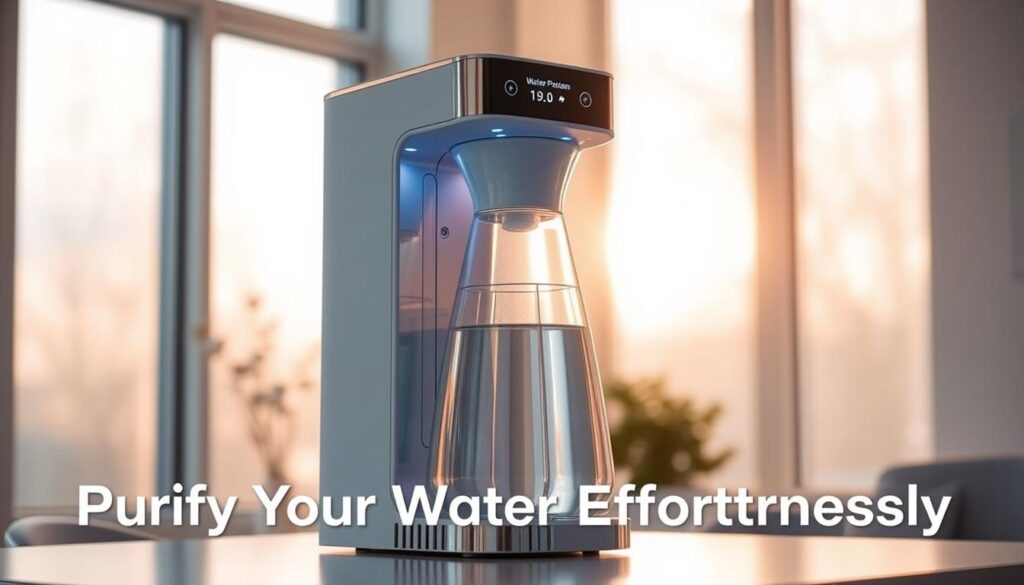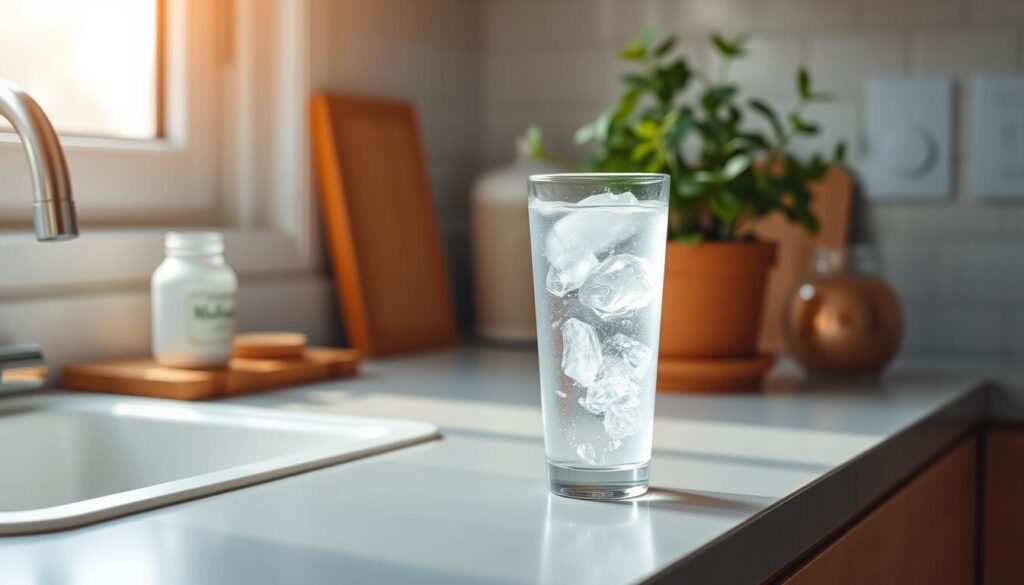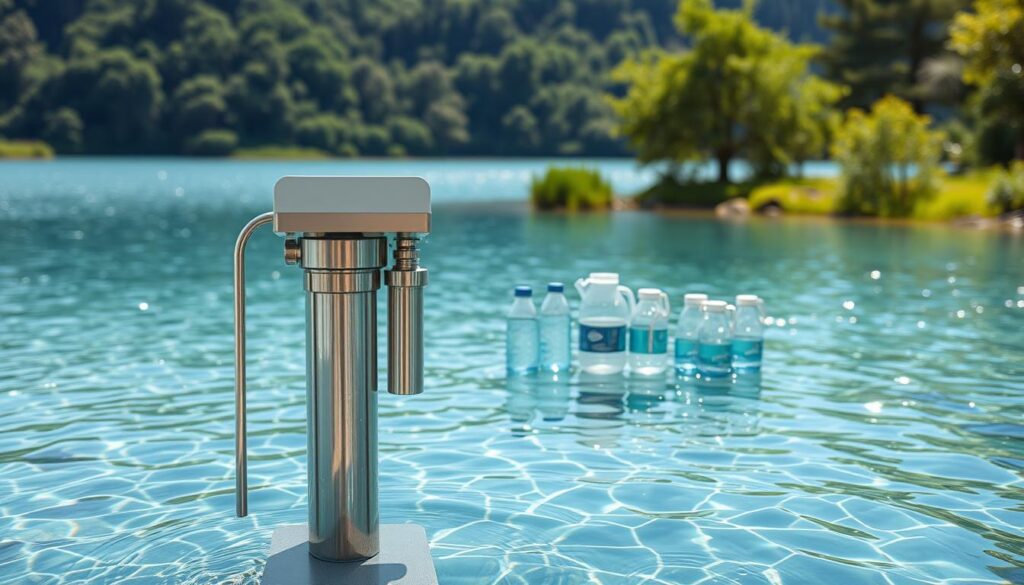Having clean drinking water is key for our health. I’ve found that it’s simpler than you might think. Knowing about home water treatment methods can really help.
There are many ways to make your water safe. I’ll share my best tips for easy water purification. This way, you can be sure your water is good to drink.
Key Takeaways
- Understand the importance of clean drinking water for health.
- Learn various methods of water purification.
- Discover top tips for effortless home water treatment.
- Find out how to remove contaminants and pathogens from water.
- Make informed decisions about your drinking water purification.
Why Water Purification Matters to Me
Having experienced the need for clean drinking water, I know how vital water purification is. It makes water safe to drink and has a big impact on our health, environment, and economy.
Understanding the Health Benefits
The health perks of water purification are many. It cuts down the risk of waterborne diseases by removing harmful stuff. The World Health Organization (WHO) says waterborne diseases are a major cause of illness and death globally. Clean drinking water is key to staying healthy, and water purification is essential for this.
- Reduces the risk of waterborne diseases
- Removes contaminants and pollutants
- Improves overall health and wellbeing
Environmental Considerations
The environmental impact of water purification is also vital. Pollutants in water can harm ecosystems and the food chain. Purifying water helps protect our environment.
Some key environmental benefits of water purification are:
- Reducing the amount of pollutants in waterways
- Protecting aquatic life and ecosystems
- Conserving water resources for future generations
Cost-Effectiveness of Clean Water
Investing in water purification systems can save money in the long run. It cuts down on bottled water costs and healthcare expenses from waterborne illnesses. Water purification is a smart financial choice.
Some cost benefits of water purification are:
- Reducing bottled water expenses
- Lowering healthcare costs associated with waterborne diseases
- Extending the lifespan of plumbing and appliances by reducing mineral buildup
For example, a reverse osmosis system can remove up to 99% of contaminants.
Common Contaminants Found in Water
Contaminants in water are a big worry for our health and the environment. I’ve looked into the different kinds of contaminants that can be in water.
Water can have many kinds of bad stuff in it. This includes germs, chemicals, and other harmful substances. These can get into our water from farms, factories, and old pipes.
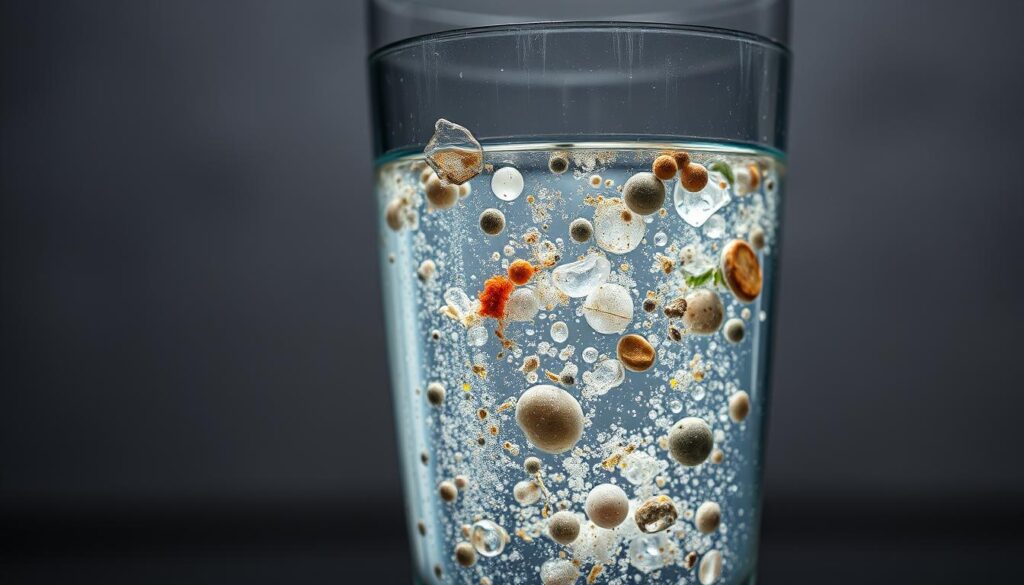
Bacteria and Viruses
Bacteria and viruses are common microbial contaminants in water. Germs like E. coli and Salmonella can make us very sick. Viruses, like Rotavirus and Norovirus, can also spread through contaminated water, causing outbreaks.
These germs can get into our water because of bad waste management and poor sanitation. But, using a UV water purifier can kill these pathogens. UV light can destroy bacteria and viruses.
Heavy Metals
Heavy metals, like lead, mercury, and arsenic, are big inorganic contaminants. They can harm our health a lot. These metals can get into our water from factories, old pipes, and nature.
Being exposed to heavy metals can cause serious health problems. It can damage our brain, kidneys, and even increase our risk of cancer. To remove these metals, we need special filters that can catch or change them.
Chemical Pollutants
Chemical pollutants include things like pesticides, herbicides, and industrial chemicals. They can get into our water from farms, factories, and bad chemical disposal.
These pollutants can affect our health in many ways. They can mess with our hormones or increase our cancer risk. To make our water safe, we can use filters like activated carbon and reverse osmosis.
In short, knowing what’s in our water is key to choosing the best way to clean it. By tackling bacteria, viruses, heavy metals, and chemicals, we can make our drinking water much better.
My Favorite Water Purification Methods
I’ve tried many water purification techniques and I’m excited to share my favorites. Clean drinking water is important to me, so I’ve looked into and tested different methods. I want to share the most effective ones with you.
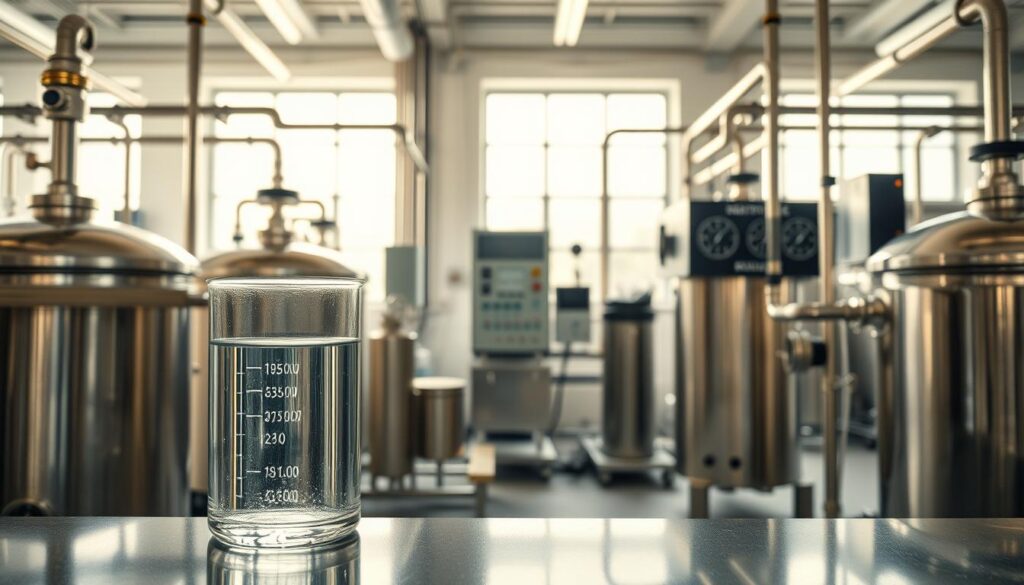
Activated Carbon Filters
Activated carbon filters are one of my top picks. They pull out impurities like chlorine, lead, and VOCs from the water. This makes the water taste better and is cleaner.
These filters are also affordable and simple to care for. They’re a good choice for many homes.
Reverse Osmosis Systems
Reverse osmosis systems are another method I like. They use a special membrane to filter out dissolved solids, bacteria, and viruses from the water.
These systems are very effective. But, they can cost more and need more upkeep than other options.
UV Purification
UV purification is also a reliable choice. It uses UV light to kill bacteria, viruses, and other microorganisms in the water.
UV purification is a chemical-free way to clean water. It’s easy to install and maintain, making it a good choice for those who want a simple solution.
In summary, these water purification methods are effective for clean drinking water. You can choose from activated carbon filters, reverse osmosis systems, or UV purification. Each method is reliable for your water needs.
Evaluating the Best Water Filter for Your Needs
Choosing the right water filter is key. Many options are out there, and each has its own benefits. It’s important to find one that fits your needs perfectly.
Water Quality Testing
First, you need to know what’s in your water. A water quality test will show you. This test tells you what kind of filter you need. For example, if your water has heavy metals, you might need a filter with activated carbon or reverse osmosis.
Flow Rate and Capacity
The flow rate and capacity are also important. The flow rate is how fast the filter works. Capacity is how much water it can handle before needing a new filter. For a family, a filter that can handle at least 100 gallons a day is best.
| Filter Type | Flow Rate (Gallons/Day) | Capacity (Gallons) |
|---|---|---|
| Activated Carbon | 50-100 | 100-200 |
| Reverse Osmosis | 20-50 | 50-100 |
| UV Purification | 100-200 | N/A |
Maintenance Requirements
Maintenance is a big part of owning a water filter. Each filter needs different care, like replacing or cleaning parts. Always check the manufacturer’s advice on maintenance. A filter that’s easy to care for can save you time and money.
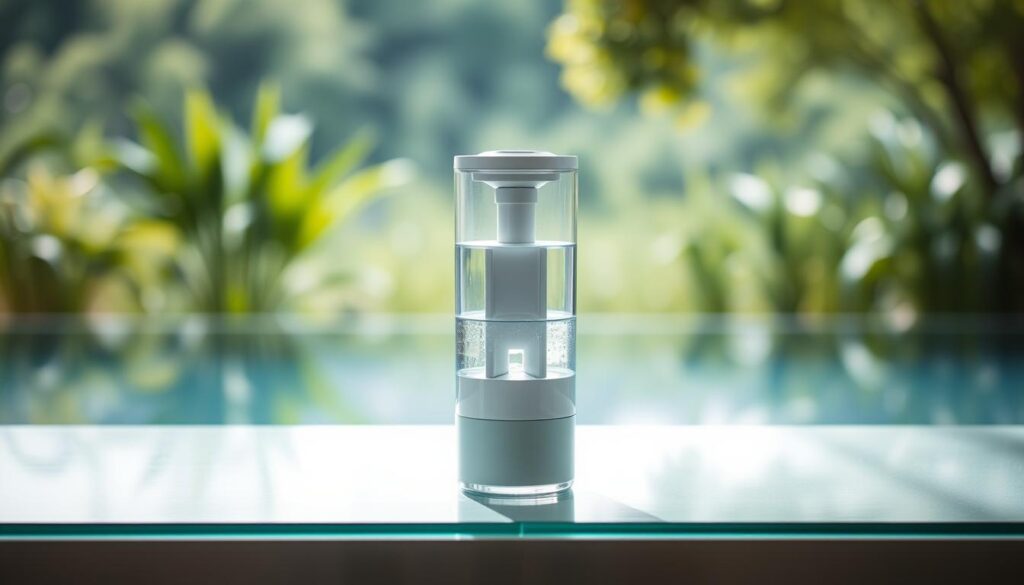
How to Maintain Your Water Purification System
Keeping your water purification system in top shape is key for a healthy life. Regular upkeep makes sure it works well and lasts longer.
Regular Filter Changes
Regular filter changes are a must for your system. Filters get clogged with dirt and can’t filter water properly. Always check your system’s manual for when to replace filters.
Filters usually need to be swapped out every 6 to 12 months. This depends on how much you use it and the filter type. Not changing filters can lower water quality and harm your system.
Cleaning Procedures
Cleaning procedures are also important. Wipe down the system’s outside to stop dust and dirt from building up. Some systems need internal cleaning, so follow the manual’s instructions for this.
- Unplug the system before cleaning
- Use a soft cloth and mild detergent for exterior cleaning
- Refer to the manual for internal cleaning instructions
Troubleshooting Common Issues
Even with regular care, problems can happen with your system. Issues like low water flow, odd tastes or smells, and leaks are common. Troubleshooting these quickly can stop bigger problems.
| Issue | Possible Cause | Solution |
|---|---|---|
| Reduced water flow | Clogged filter | Replace the filter |
| Strange taste or odor | Expired or contaminated filter | Replace the filter |
| System leak | Loose connections or damaged parts | Tighten connections or replace damaged parts |
By following these tips, you can keep your system running smoothly. This includes regular filter changes, cleaning, and fixing common problems. Also, using a water softener can help keep minerals from building up, making your system work better and last longer.
Understanding the Science Behind Water Purification
Exploring water purification reveals a fascinating science that’s vital for our health. It’s a complex process that removes harmful substances from water, making it safe to drink.
Water purification systems work through physical, chemical, and biological methods. Knowing these principles helps us appreciate the technology behind clean water.
Physical Filtration
Physical filtration is a key method in water purification. It uses filters like activated carbon or membranes to catch particles and microorganisms. The filter’s size affects how well it filters out contaminants.
Key characteristics of physical filtration include:
- Effectiveness in removing particulate matter and microorganisms
- Variety of filter media available, such as activated carbon and ceramic
- Importance of filter pore size in determining contaminant removal
| Filter Type | Pore Size | Contaminants Removed |
|---|---|---|
| Activated Carbon | 1-100 microns | Chlorine, taste, odor, some bacteria |
| Ceramic | 0.2-1 microns | Bacteria, viruses, parasites |
| Membrane | 0.0001-0.1 microns | Heavy metals, bacteria, viruses, parasites |
Chemical Processes
Chemical processes are vital in water purification, focusing on dissolved contaminants. Methods like coagulation, disinfection, and ion exchange help remove chemicals.
Coagulation adds chemicals to water to remove dirt and particles. Disinfection, often through chlorination or ozonation, kills bacteria and viruses. Ion exchange systems remove heavy metals and other compounds.
Biological Methods
Biological methods use living organisms to purify water. Slow sand filtration and biological activated carbon are examples of these processes.
These methods depend on beneficial bacteria and microorganisms to break down organic matter. They are effective in removing a wide range of contaminants, including nutrients and chemicals.
DIY Water Purification Techniques I Trust
Having reliable DIY water purification methods is key for clean drinking water. This is true in emergencies or when tech is not around.
Boiling Water
Boiling water is simple and effective. Boiling for 1-3 minutes kills bacteria and viruses. It’s a method used for centuries.
To boil water well, use a clean pot. Make sure the water boils fully. Let it cool before drinking. Boiling doesn’t remove chemicals but kills biological threats.
Solar Distillation
Solar distillation uses the sun to purify water. It involves evaporating water and then condensing it, leaving contaminants behind.
To make a solar distiller, you need a container, a bowl, and a plastic sheet. Place the container in sunlight. Weigh down the plastic sheet’s center. The water evaporates, condenses, and drips into the bowl, making clean water.
Household Remedies
Some household remedies can purify water. Activated charcoal or clay can remove impurities. These methods are not as good as boiling or solar distillation but can help.
Not all household remedies work. Some say fruits or plants can purify water, but these claims are often not backed by science. For more info, check out this resource to learn about DIY water purification myths.
By using these DIY water purification methods, you can make your drinking water better, even in tough situations.
Choosing a Water Purification System for Home Use
Choosing the right water purification system for your home is important. It ensures you have clean drinking water. The right system can make a big difference.
Budget Considerations
Your budget is a key factor. Water purification systems vary in price. Activated carbon filters are often cheaper, while reverse osmosis systems cost more but purify more thoroughly.
Think about the cost over time, not just the initial price. Systems with easy-to-replace filters can save you money.
Space and Installation
Consider the space you have and how easy it is to install the system. Countertop models are small and easy to set up. Whole-house systems need more space and might require a pro.
Check the space where you’ll put the system. Also, think about if you can install it yourself or if you need a professional.
Brand Recommendations
Some brands are known for their quality. Aquasana and ZeroWater are top choices.
| Brand | System Type | Price Range |
|---|---|---|
| Aquasana | Activated Carbon, Reverse Osmosis | $50 – $500 |
| ZeroWater | Reverse Osmosis | $200 – $600 |
| Berkey | Gravity-Based Filters | $100 – $300 |
The best system for you depends on your needs, budget, and preferences. Research well to choose a system that gives you clean, safe water.
Safety Tips for Purified Water Storage
Storing purified water right is key to keeping it safe and clean. After getting a good water purifier, like a UV one, you must store the water well. This stops it from getting dirty again.
Container Selection and Preparation
Choosing the right container for purified water storage is important. I suggest using containers made of strong plastic, ceramic, or metal. They should have a small opening that can be closed tightly.
The container needs to be cleaned with soap and water. Then, sanitize it with unscented chlorine bleach. Let it dry before you use it.
Storage Best Practices
Keep your purified water in a cool, dark spot. It should be away from harmful things. Always check the water for signs of contamination.
Look out for odd smells, colors, or dirt. By doing this, you can keep your water safe and clean for longer.
FAQ
What is the most effective method for purifying water at home?
Using a reverse osmosis system and a UV water purifier together is best. They protect against bacteria, viruses, and heavy metals.
How often should I change the filters in my water purification system?
Filter change frequency varies by type and manufacturer’s advice. Usually, replace filters every 6-12 months for best results.
Can I use a water softener in conjunction with a water purification system?
Yes, you can use a water softener with a purification system. It removes minerals causing hard water. The purification system then removes other contaminants.
What are the benefits of using an activated carbon filter for water purification?
Activated carbon filters remove chlorine, lead, and VOCs. They improve water taste and odor. They can be used alone or as a pre-filter.
How do I know if my water purification system is working effectively?
Regular water quality tests show if the system works. Look for certifications from NSF International for assurance.
Can I purify water using DIY methods, such as boiling or solar distillation?
Yes, boiling and solar distillation work in emergencies or without advanced tech. But, they might not remove all contaminants. Always follow proper procedures.
What are the signs of contamination in stored purified water?
Look for sediment, odd smells, or taste changes in stored water. Regular testing catches issues early.
How do I choose the right water purification system for my home?
Consider budget, space, and installation needs. Also, think about your water’s contaminants. Choose systems certified by third-party organizations.
What is the importance of proper container selection for storing purified water?
Choosing the right container is key to keeping water clean. Containers should be clean, airtight, and food-grade to keep water safe.

